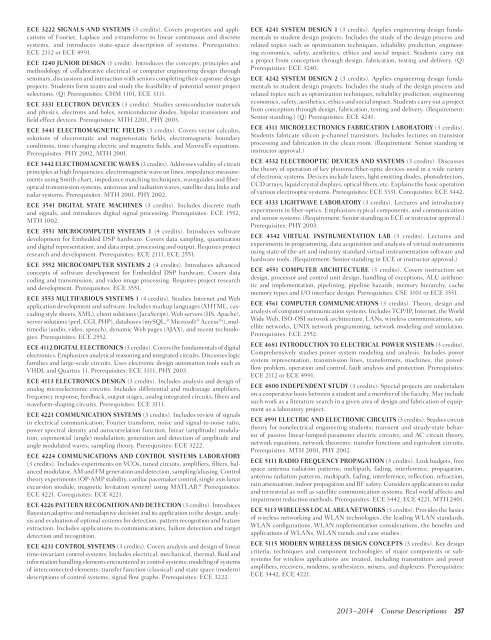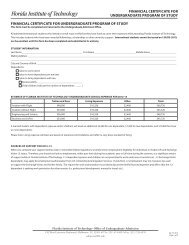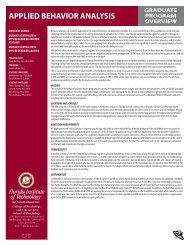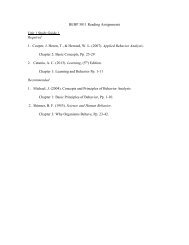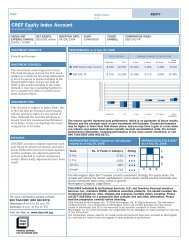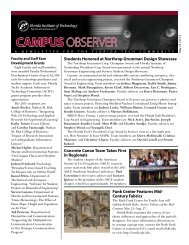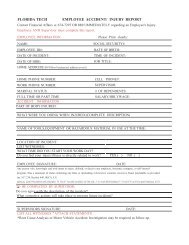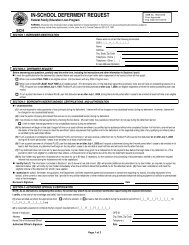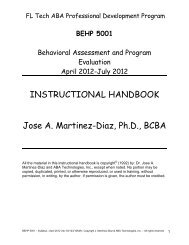2013–2014 UNIVERSITY CATALOG - Florida Institute of Technology
2013–2014 UNIVERSITY CATALOG - Florida Institute of Technology
2013–2014 UNIVERSITY CATALOG - Florida Institute of Technology
Create successful ePaper yourself
Turn your PDF publications into a flip-book with our unique Google optimized e-Paper software.
ECE 3222 SIGNALS AND SYSTEMS (3 credits). Covers properties and applications<br />
<strong>of</strong> Fourier, Laplace and z-transforms to linear continuous and discrete<br />
systems, and introduces state-space description <strong>of</strong> systems. Prerequisites:<br />
ECE 2112 or ECE 4991.<br />
ECE 3240 JUNIOR DESIGN (1 credit). Introduces the concepts, principles and<br />
methodology <strong>of</strong> collaborative electrical or computer engineering design through<br />
seminars, discussions and interaction with seniors completing their capstone design<br />
projects. Students form teams and study the feasibility <strong>of</strong> potential senior project<br />
selections. (Q) Prerequisites: CHM 1101, ECE 3111.<br />
ECE 3331 ELECTRON DEVICES (3 credits). Studies semiconductor materials<br />
and physics, electrons and holes, semiconductor diodes, bipolar transistors and<br />
field effect devices. Prerequisites: MTH 2201, PHY 2003.<br />
ECE 3441 ELECTROMAGNETIC FIELDS (3 credits). Covers vector calculus,<br />
solutions <strong>of</strong> electrostatic and magnetostatic fields, electromagnetic boundary<br />
conditions, time-changing electric and magnetic fields, and Maxwell’s equations.<br />
Prerequisites: PHY 2002, MTH 2001.<br />
ECE 3442 ELECTROMAGNETIC WAVES (3 credits). Addresses validity <strong>of</strong> circuit<br />
principles at high frequencies, electromagnetic wave on lines, impedance measurements<br />
using Smith chart, impedance matching techniques, waveguides and fiberoptical<br />
transmission systems, antennas and radiation waves, satellite data links and<br />
radar systems. Prerequisites: MTH 2001, PHY 2002.<br />
ECE 3541 DIGITAL STATE MACHINES (3 credits). Includes discrete math<br />
and signals, and introduces digital signal processing. Prerequisites: ECE 1552,<br />
MTH 1002.<br />
ECE 3551 MICROCOMPUTER SYSTEMS 1 (4 credits). Introduces s<strong>of</strong>tware<br />
development for Embedded DSP hardware. Covers data sampling, quantization<br />
and digital representation, and data input, processing and output. Requires project<br />
research and development. Prerequisites: ECE 2111, ECE 2551.<br />
ECE 3552 MICROCOMPUTER SYSTEMS 2 (4 credits). Introduces advanced<br />
concepts <strong>of</strong> s<strong>of</strong>tware development for Embedded DSP hardware. Covers data<br />
coding and transmission, and video image processing. Requires project research<br />
and development. Prerequisites: ECE 3551.<br />
ECE 3553 MULTIFARIOUS SYSTEMS 1 (4 credits). Studies Internet and Web<br />
application development and s<strong>of</strong>tware. Includes markup languages (XHTML, cascading<br />
style sheets, XML), client solutions (JavaScript), Web servers (IIS, Apache),<br />
server solutions (perl, CGI, PHP), databases (mySQL, ® Micros<strong>of</strong>t ® Access ®s ), multimedia<br />
(audio, video, speech), dynamic Web pages (AJAX), and recent technologies.<br />
Prerequisites: ECE 2552.<br />
ECE 4112 DIGITAL ELECTRONICS (3 credits). Covers the fundamentals <strong>of</strong> digital<br />
electronics. Emphasizes analytical reasoning and integrated circuits. Discusses logic<br />
families and large-scale circuits. Uses electronic design automation tools such as<br />
VHDL and Quartus 11. Prerequisites: ECE 3111, PHY 2003.<br />
ECE 4113 ELECTRONICS DESIGN (3 credits). Includes analysis and design <strong>of</strong><br />
analog microelectronic circuits. Includes differential and multistage amplifiers,<br />
frequency response, feedback, output stages, analog integrated circuits, fibers and<br />
waveform-shaping circuits. Prerequisites: ECE 3111.<br />
ECE 4221 COMMUNICATION SYSTEMS (3 credits). Includes review <strong>of</strong> signals<br />
in electrical communication; Fourier transform, noise and signal-to-noise ratio,<br />
power spectral density and autocorrelation function, linear (amplitude) modulation;<br />
exponential (angle) modulation; generation and detection <strong>of</strong> amplitude and<br />
angle modulated waves; sampling theory. Prerequisites: ECE 3222.<br />
ECE 4224 COMMUNICATIONS AND CONTROL SYSTEMS LABORATORY<br />
(3 credits). Includes experiments on VCOs, tuned circuits, amplifiers, filters, balanced<br />
modulator, AM and FM generation and detection, sampling/aliasing. Control<br />
theory experiments (OP-AMP stability, cardiac pacemaker control, single axis lunar<br />
excursion module, magnetic levitation system) using MATLAB. ® Prerequisites:<br />
ECE 4221. Corequisites: ECE 4221.<br />
ECE 4226 PATTERN RECOGNITION AND DETECTION (3 credits). Introduces<br />
Bayesian adaptive and nonadaptive decision and its application to the design, analysis<br />
and evaluation <strong>of</strong> optimal systems for detection, pattern recognition and feature<br />
extraction. Includes applications to communications, failure detection and target<br />
detection and recognition.<br />
ECE 4231 CONTROL SYSTEMS (3 credits). Covers analysis and design <strong>of</strong> linear<br />
time-invariant control systems. Includes electrical, mechanical, thermal, fluid and<br />
information handling elements encountered in control systems; modeling <strong>of</strong> systems<br />
<strong>of</strong> interconnected elements; transfer function (classical) and state space (modern)<br />
descriptions <strong>of</strong> control systems; signal flow graphs. Prerequisites: ECE 3222.<br />
ECE 4241 SYSTEM DESIGN 1 (3 credits). Applies engineering design fundamentals<br />
to student design projects. Includes the study <strong>of</strong> the design process and<br />
related topics such as optimization techniques, reliability prediction, engineering<br />
economics, safety, aesthetics, ethics and social impact. Students carry out<br />
a project from conception through design, fabrication, testing and delivery. (Q)<br />
Prerequisites: ECE 3240.<br />
ECE 4242 SYSTEM DESIGN 2 (3 credits). Applies engineering design fundamentals<br />
to student design projects. Includes the study <strong>of</strong> the design process and<br />
related topics such as optimization techniques, reliability prediction, engineering<br />
economics, safety, aesthetics, ethics and social impact. Students carry out a project<br />
from conception through design, fabrication, testing and delivery. (Requirement:<br />
Senior standing.) (Q) Prerequisites: ECE 4241.<br />
ECE 4311 MICROELECTRONICS FABRICATION LABORATORY (3 credits).<br />
Students fabricate silicon p-channel transistors. Includes lectures on transistor<br />
processing and fabrication in the clean room. (Requirement: Senior standing or<br />
instructor approval.)<br />
ECE 4332 ELECTROOPTIC DEVICES AND SYSTEMS (3 credits). Discusses<br />
the theory <strong>of</strong> operation <strong>of</strong> key photonic/fiber-optic devices used in a wide variety<br />
<strong>of</strong> electronic systems. Devices include lasers, light emitting diodes, photodetectors,<br />
CCD arrays, liquid crystal displays, optical fibers, etc. Explains the basic operation<br />
<strong>of</strong> various electrooptic systems. Prerequisites: ECE 3331. Corequisites: ECE 3442.<br />
ECE 4333 LIGHTWAVE LABORATORY (3 credits). Lectures and introductory<br />
experiments in fiber-optics. Emphasizes typical components, and communication<br />
and sensor systems. (Requirement: Senior standing in ECE or instructor approval.)<br />
Prerequisites: PHY 2003.<br />
ECE 4342 VIRTUAL INSTRUMENTATION LAB (3 credits). Lectures and<br />
experiments in programming, data acquisition and analysis <strong>of</strong> virtual instruments<br />
using state-<strong>of</strong>-the-art and industry standard virtual instrumentation s<strong>of</strong>tware and<br />
hardware tools. (Requirement: Senior standing in ECE or instructor approval.)<br />
ECE 4551 COMPUTER ARCHITECTURE (3 credits). Covers instruction set<br />
design, processor and control unit design, handling <strong>of</strong> exceptions, ALU arithmetic<br />
and implementation, pipelining, pipeline hazards, memory hierarchy, cache<br />
memory types and I/O interface design. Prerequisites: CSE 3101 or ECE 3551.<br />
ECE 4561 COMPUTER COMMUNICATIONS (3 credits). Theory, design and<br />
analysis <strong>of</strong> computer communication systems. Includes TCP/IP, Internet, the World<br />
Wide Web, ISO-OSI network architecture, LANs, wireless communications, satellite<br />
networks, UNIX network programming, network modeling and simulation.<br />
Prerequisites: ECE 2552.<br />
ECE 4681 INTRODUCTION TO ELECTRICAL POWER SYSTEMS (3 credits).<br />
Comprehensively studies power system modeling and analysis. Includes power<br />
system representation, transmission lines, transformers, machines, the powerflow<br />
problem, operation and control, fault analysis and protection. Prerequisites:<br />
ECE 2112 or ECE 4991.<br />
ECE 4800 INDEPENDENT STUDY (3 credits). Special projects are undertaken<br />
on a cooperative basis between a student and a member <strong>of</strong> the faculty. May include<br />
such work as a literature search in a given area <strong>of</strong> design and fabrication <strong>of</strong> equipment<br />
as a laboratory project.<br />
ECE 4991 ELECTRIC AND ELECTRONIC CIRCUITS (3 credits). Studies circuit<br />
theory for nonelectrical engineering students; transient and steady-state behavior<br />
<strong>of</strong> passive linear-lumped-parameter electric circuits; and AC circuit theory,<br />
network equations, network theorems; transfer functions and equivalent circuits.<br />
Prerequisites: MTH 2001, PHY 2002.<br />
ECE 5111 RADIO FREQUENCY PROPAGATION (3 credits). Link budgets, free<br />
space antenna radiation patterns, multipath, fading, interference, propagation,<br />
antenna radiation patterns, multipath, fading, interference, reflection, refraction,<br />
rain attenuation, indoor propagation and RF safety. Considers applications to radar<br />
and terrestrial as well as satellite communication systems. Real world affects and<br />
impairment reduction methods. Prerequisites: ECE 3442, ECE 4221, MTH 2401.<br />
ECE 5113 WIRELESS LOCAL AREA NETWORKS (3 credits). Provides the basics<br />
<strong>of</strong> wireless networking and WLAN technologies, the leading WLAN standards,<br />
WLAN configurations, WLAN implementation considerations, the benefits and<br />
applications <strong>of</strong> WLANs, WLAN trends and case studies.<br />
ECE 5115 MODERN WIRELESS DESIGN CONCEPTS (3 credits). Key design<br />
criteria, techniques and component technologies <strong>of</strong> major components or subsystems<br />
for wireless applications are treated, including transmitters and power<br />
amplifiers, receivers, modems, synthesizers, mixers, and duplexers. Prerequisites:<br />
ECE 3442, ECE 4221.<br />
<strong>2013–2014</strong> Course Descriptions 257


